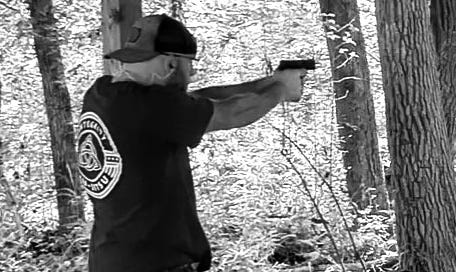There are only three martial arts. To be clear, we are talking about the “artistry” that overlaps varying degrees of violence with sport.
Real violence doesn’t care what martial art you practice or what TikTok says is “the best.” Martial efficacy out in the wilds of the world is pretty simple. Survive… by any and whatever means necessary.
While that’s not the topic of this article, it had to be said to clear the air.
I believe I first heard the idea of “only three martial arts” from a Jocko podcast. I was at the range with a friend the other day and we discussed the same idea and how it paints a clear escalation from “sport” to “real self defense.”
The three disciplines are:
Grappling
Striking
Weapons
They are delineated by differing amounts of force (damage) and the speed, as well as ranges, that they can deliver that damage.
Grappling:
Grappling is the closest to other “sports.” However, if you’ve ever watched an Olympic wrestling match, there’s no question that it is in fact a “combat” sport.
It is the closest to other sports because of the control and corresponding reduction in variables that occur – rules of engagement if you will.
The entire premise of grappling – across all disciplines – is control. What’s more is that that control is invoked via “grabbing.”
This is a fundamental distinction. In order for my “sport of grappling” skills to be helpful in a martial sense, I need to be close enough to grab someone (range).
The other major distinction (speed) also becomes apparent when you consider that even “chain wrestling” or “fast submissions” or “explosive throws” are still relatively slow compared to the factions of a second in which strikes fly.
Striking:
Obviously you can strike from close range as well – ala “ground-and-pound.” Straight hand strikes, and especially leg strikes, tend to come from ranges outside of where you can “grab” someone.
If you’re remotely savvy to MMA at all you know that good grappling is next to useless in that context unless the closer range skill (grappling) is effectively set up with the longer range skill (striking); because participants start the engagement outside of both of those ranges (in their corners).
Striking also introduces more chaos into the engagement. Everyone has “a puncher’s chance.” Knockouts come “out of nowhere” far more often than takedowns or pins.
Saying “your hands are weapons” isn’t just a catchphrase for wannabe tough guys. It’s actually a point of fact. I’m striking you with the “weapon” of the hard bones in a compressed hand, sharp elbow, etc.
To make this picture a little clearer, a pair of “brass knuckles” or a roll of quarters in your palm only adds a few ounces of weight to your hand. The load is light enough that “hand speed” is relatively the same, and the delivered force – queue your high school physics class – is exponentially greater.
We can take things even further by looking at handheld “striking” weapons – baseball bat, eskrima stick, knife, etc. – and you can see how quickly “force” (and violence) are multiplied.
Weapons:
Really what we’re talking about here are projectiles. The knife (or axe if you insist) can be wielded or thrown. While the range of the latter is limited, it’s still much further than striking distance.
Any legitimate self-defense instructor ought to tell you to forget everything you know about fighting once weapons are introduced into the situation. Go ahead – Google “knife fight injury” if you don’t believe me. Never mind the news headlines of many famed grapplers and strikers who have met an untimely death at the end of a barrel – trying to play hero or otherwise.
My Tyson’s legendary knockout power was around 1,800 PSI. A 9mm cartridge hits at about 20x that. I didn’t vet sources, but you get the picture.
Additionally projectile ranges aren’t measured in inches (like striking “reach”), it’s measured in yards – a 36x factor. There’s a reason the expression “bullet-time” only exists in movies and comic books.
Lastly, weapons are the most chaotic environment particularly because of their damage potential and risk of that damage becoming “collateral” – or “not neat, clean, or under your possession.”
Full Circle:
I said I wasn’t going to make this post about self-defense, so I’ll keep the wrap up brief.
Your average sporty athlete is going to get mauled by a NCAA wrestler. That same wrestler would get picked apart by someone with same time and talent in muay thai – given, as we said, we’re operating in a 10’ ring versus a crowded convenient store.
That striker? He may find himself with 10+ 9mm presents at the hands of the gentleman the wrestler mauled – again, if we extend that ring to 16’ and put them in the corners. You don’t need a PhD to pull a trigger.
There are a million variables that could (and should) factor into “real violence” or “real self defense” training, but that’s not the point of this article.
The point is that virtually any and all martial arts, whether you consider them “traditional” or “reality based”, involve distinct components of either (and sometimes including): striking, grappling, and weapons. This is so much the case that their common classification among participants is based on these categories.
Am I grabbing someone?
Am I hitting someone (with something)?
Are projectiles cast?
They all require immense amounts of skill to exhibit gracefully. Though their distinctions vary based on:
Amount of force (PSI) applied.
Speed of applied force.
Range of applied force.




